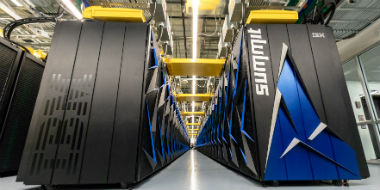Cognitive Commerce
Delivering Science-Enabling Supercomputers for DOE’s Energy Mission
August 11, 2016 | Written by: mrzimmerman
Categorized: Cognitive Commerce | Supercomputing
Share this post:
With the right tools, seemingly impossible problems can rapidly shift to the realm of possibility. This is true whether you’re talking about a simple one-person task or a complex challenge taken on by a group of committed individuals.
Complex problems are second nature at the US Department of Energy (DOE). The agency is dedicated to addressing many of the most pressing challenges facing the world, from climate change and nuclear security, to sustainable energy. Positively affecting such large-scale challenges to human health and prosperity requires powerful, dynamic, and flexible tools for scientific and technological innovation.
The DOE has such an infrastructure in one of the leading supercomputing facilities in the world, the Oak Ridge Leadership Computing Facility (OLCF). This DOE Office of Science User Facility located at Oak Ridge National Laboratory (ORNL) provides the DOE with some of its most versatile resources.
For example, the OLCF’s current leadership-class machine Titan tackles grand challenges in basic and applied research. Additionally, we are working with IBM and fellow OpenPOWER Foundation members NVIDIA and Mellanox to build our next-generation supercomputer, Summit.
Upon arrival in 2018, Summit will represent a major step toward the realization of exascale computing, supercomputers that can carry out one billion billion calculations per second.
While the speed of computing is impressive, the quest for new scientific knowledge gives it purpose. The heart of OLCF’s mission is to help scientists from around the world solve mysteries as fundamental as the nature of matter and as critical as how human activity is affecting the planet. In addition to delivering scientific discoveries, this work is bolstering the competitiveness of industry.
Using Titan, a team from Imperial College, led by Department of Aeronautics senior lecturer Peter Vincent, is developing a highly accurate, highly flexible fluid dynamics code called PyFR that allows companies in industries as diverse as aerospace, car manufacturing, and wind power to exploit petascale computing.
Adoption of the open-source code by industry will allow researchers to better resolve critical design problems, augment physical testing, and deliver superior products.
Beyond providing the raw computing power needed to carry out high-fidelity simulation and advanced data analysis, OLCF systems are being applied to develop data-driven techniques that make new connections among fragmented knowledge that already exists.
One such project led by Georgia Tourassi, director of ORNL’s Health Data Sciences Institute, aims to apply computationally demanding machine learning and natural language processing to extract insights related to cancer from readily available health datasets, such as text-based reports on cancerous tissue samples.
This research has the potential to offer a fully automated and cost-effective method to accelerating knowledge discovery, a high priority of the National Cancer Institute, by helping medical researchers identify and prioritize long-term studies.
In related work, as part of DOE’s contribution to the White House Cancer Moonshot, Tourassi and ORNL researchers will be harnessing OLCF resources to lead a pilot project dedicated to cancer surveillance.
The goal is create analytics capabilities that will contribute to the prevention, detection, and treatment of cancer and improve patient outcomes.
The Future of US Supercomputing
For the DOE, continued innovation in science and technology depends on the invention, construction, and deployment of the next paradigm-shifting tools of discovery.
Our work with IBM and the OpenPOWER Foundation will expand and significantly improve upon Titan’s heterogeneous architecture made up of graphics processing units (GPUs) and central processing units (CPUs).
When delivered, Summit will provide more than 8 times the computational power of its predecessor due to the tighter integration between CPU and GPU via NVIDIA NVLink. In conjunction with assembling Summit’s hardware, application teams composed of scientific users, OLCF staff, and representatives from the IBM/NVIDIA Center of Excellence are optimizing a suite of scientific codes—from domains as diverse as biophysics, materials science, and climate modeling—that will make effective use of this next-generation machine.
In the wake of President Obama’s July 2015 executive order to establish the National Strategic Computing Initiative, supercomputing’s role in maintaining the United States’ global competitiveness has never been clearer. Since the President’s call, leading scientists and government organizations have come together to create a formal plan to deliver a DOE exascale machine within the next decade.
With Summit and a future exascale system on the horizon, the scope and scale of DOE’s toolbox will grow exponentially, ensuring scientists will continue to look to the US to access to the world’s best computational tools to further our understanding of nature and deliver solutions related to energy, health, and much more.

Global Program Manager, Cloud Communications; Managing Editor, IBM THINK Blog
New Advances in Green IT
What does COVID-19 have in common with climate change? Supercomputers are an important tool in fighting both of them. In collaboration with the White House Office of Science and Technology Policy and the U.S. Department of Energy and many others, IBM helped launch the COVID-19 High Performance Computing Consortium, which assembled massive supercomputing power to […]
IBM’s Robert H. Dennard and the Chip That Changed the World
The inspiration, as is often the case, came late one evening. Bob Dennard, then a 34-year-old IBM electrical engineer, was pondering a colleague’s research presentation he’d seen earlier that day. It was autumn 1966, and Dennard had been helping design a new form of computer memory using silicon-based transistors. This approach, known as microelectronics, would […]
AI Supercomputing and the Enterprise
In June 2008, the well-named IBM Roadrunner supercomputer blew past all competitors by clocking at compute speeds no system on the planet had achieved before. Fast forward 10 years to June 2018. IBM and the U.S. Department of Energy debuted Summit, the world’s smartest and most powerful supercomputer, capable of 200 million calculations, a million […]


